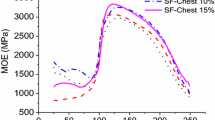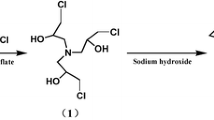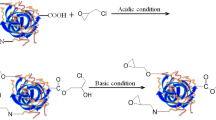Abstract
In this research tannic acid was used to prepare soy-based adhesives for making plywood and fiber board. The different resin formulations were analyzed by Differential scanning calorimetry (DSC), thermogravimetric analysis (TGA) and its derivative as a function of temperature (DTG) and Fourier Transform Infra-red (FTIR) spectroscopy. The results showed that the addition of tannic acid to soy-based adhesive decreased soy-based adhesive viscosity and its pH. The DSC analysis showed that the denaturation temperature of soy-based adhesives decrease by adding tannic acid. The TGA and DTG curves showed that the thermal degradation of soy flour starts above 146 °C. The FTIR spectroscopy results also showed that the soy flour amino acids appeared to react well with tannic acid. Furthermore, delamination and shear strength test results showed the good water resistance of plywood bonded with soy-based tannic acid-modified adhesive. The mechanical and physical properties such as MOR, MOE, IB, and water resistance of fiberboard were improved, by adding tannic acid to the soy-based adhesive.





Similar content being viewed by others
References
Pizzi A (2016) Wood products and green chemistry. Ann For Sci 73:185–203
Raqueza JM, Deleglise M, Lacrampea MF, Krawczak P (2010) Thermosetting (bio)materials derived from renewable resources: a critical review. Prog Polym Sci 35:487–509
Schwarzkopf M, Huang J, Li K (2010) A formaldehyde-free soy-based adhesive for making oriented strandboard. J Adhes 86:352–364
Frihart CR, Satori HJ (2013) Soy flour dispersibility and performance as wood adhesive. Adhes Sci Technol 27:2043–2052
Luo J, Li L, Luo J, Li X, Li K, Gao Q (2016) A high solid content bioadhesive derived from soybean meal and egg white: preparation and properties. J Polym Environ. doi:10.1007/s10924-016-0875-3
Hettiarachchy NS, Kalapathy U, Myers DJ (1995) Alkali-modified soy protein with improved adhesive and hydrophobic properties. J Am Oil Chem Soc 72:1461–1464
Huang J, Li K (2008) A new soy flour-based adhesive for making interior type II plywood. J Am Oil Chem Soc 85:63–70
Sun X, Bian K (1999) Shear strength and water resistance of modified soy protein adhesives. J Am Oil Chem Soc 76:977–980
Eslah F, Jonoobi M, Faezipour M, Afsharpour M, Enayati AA (2016) Preparation and development of a chemically modified bio-adhesive derived from soybean flour protein. Int J Adhes Adhes 71:48–54
Zhu D, Damodaran S (2014) Chemical phosphorylation improves the moisture resistance of soy flour-based wood adhesive. J Appl Polym Sci. doi:10.1002/APP.40451
Allen AJ, Marcink JJ, Wagler TA, Sosnowick AJ (2010) Investigations of the molecular interactions of soy-based adhesives. For Prod J 60:534–540
Wescott JM, Frihart CR, Traska AE (2006) High-soy-containing water-durable adhesives. J Adhes Sci Technol 20:859–873
Tabarsa T, Jahanshahi SH, Ashori A (2011) Mechanical and physical properties of wheat straw boards bonded with a tannin modified phenol-formaldehyde adhesive. Compos Part B 42:176–180
Luo J, Luo J, Li X, Li K, Qiang Gao Q, Li J (2016) Toughening improvement to a soybean meal-based bioadhesive using an interpenetrating acrylic emulsion network. J Mater Sci 51:9330–9341
Widsten P, Heathcote C, Kandelbauer A, Guebitz G, Nyanhongo GS, Prasetyo EN, Kudanga T (2010) Enzymatic surface functionalisation of lignocellulosic materials with tannins for enhancing antibacterial properties. Process Biochem 45:1072–1081
Bozic M, Gorgieva S, Kokol V (2012) Homogeneous and heterogeneous methods for laccase-mediated functionalization of chitosan by tannic acid and quercetin. Carbohydr Polym 89:854–864
Aelenei N, Popa MI, Novac O, Lisa G, Balaita L (2009) Tannic acid incorporation in chitosan-based microparticles and in vitro controlled release. J Mater Sci 20:1095–1102
Van Buren JP, Robinson WB (1969) Formation of complexes between protein and tannic acid. J Agric Food Chem 17:772–777
Oh H, Hoff JE, Armstrong GS, Haff LA (1980) Hydrophobic interaction in tannin-protein complexes. J Agric Food Chem 28:394–398
Sionkowska A, Kaczmarek B, Lewandowska K (2014) Modification of collagen and chitosan mixtures by the addition of tannic acid. J Mol Liq 199:318–323
Xu F, Weng B, Gilkerson R, Materon LA, Lozano K (2015) Development of tannic acid/chitosan/pullulan composite nano-fibers from aqueous solution for potential applications as wound dressing. Carbohydr Polym 115:16–24
Rubentheren V, Ward TA, Chee CY, Tang CK (2015) Processing and analysis of chitosan nanocomposites reinforced with chitin whiskers and tannic acid as a crosslinker. Carbohydr Polym 115:379–387
Koupantsis T, Pavlidou E, Paraskevopoulou A (2016) Glycerol and tannic acid as applied in the preparation of milk proteins—CMC complex coavervates for flavour encapsulation. Food Hydrocoll 57:62–71
Gao Q, Shi Q, Li J, Liang K, Zhang X (2011) Soybean meal-based wood adhesives enhanced by modified polyacrylic acid solution. Bioresources 7:946–956
Wang WH, Li XP, Zhang XQ (2008) A soy-based adhesive from basic modification. Pigment Resin Technol 37:93–97
Tian K, Porter D, Yao J, Shao ZH, Chen X (2010) Kinetics of thermally-induced conformational transitions in soybean protein films. Polymer 51:2410–2416.
Schmidt V, Soldi V (2006) Influence of polycaprolactone-triol addition on thermal stability of soy protein isolate based films. Polym Degrad Stab 91:3124–3130.
Nanda PK, Rao KK, Nayak PL (2007) Biodegradable polymers. XI. Spectral, thermal, morphological and biodegradability properties of environment-friendly green plastics of soy protein modified with thiosemicarbazide. J Appl Polym Sci 103:3134–3142
Kumar R, Choudhary V, Mishra S, Varma IK (2004) Enzymatically-modified soy protein part 2: adhesion behavior. J Adhes Sci Technol 18:261–273
Su JF, Huang Z, Yuan XY, Wang XY, Li M (2010) Structure and properties of carboxymethyl cellulose/soy protein isolate blend edible films crosslinked by Maillard reactions. Carbohydr Polym 79:145–153
Pantoja-Castroa MA, González-Rodrígueza H (2012) Study by infrared spectroscopy and thermogravimetric analysis of tannins and tannic acid. Rev Latinoam Quím 39:107–112
Socrates G (2004) Infrared and raman characteristics group frequencies. John Wiley & Sons
Silverstein RM, Webster FX, Kiemle DJ, Bryce DL (2014) Spectrometric identification of organic compounds. John Wiley & Sons
Stuart BH (2005) Experimental methods in infrared spectroscopy: fundamentals and applications. Wiley, Chichester
Manivannan M, Rajendran S (2011) Investigation of inhibitive action of urea- zn2+ system in the corrosion control of carbon steel in sea water. Int J Eng Sci Technol 3:8048–8060
Keuleers R, Desseyn HO, Rousseau B, Van Alsenoy C (1999) Vibrational analysis of urea. J Phys Chem 103:4621–4630
Charlton AJ, Baxter NJ, Lokmankhan M, Moir AJ, Haslam E, Davies AP, Williamson MP (2002) Polyphenol/peptide binding and precipitation. J Agric Food Chem 50:1593–1601
Ghahri S, Pizzi A, Mohebby B, Mirshokraie A, Mansouri HR (2016) Soy-based, tannin-modified plywood adhesives. J Adhes. doi:10.1080/00218464.2016.1258310
Guang-Heng W, An-ning Z, Xiao-Bing H (2006) Effect of coal filler on the properties of soy protein plastics. J Appl Polym Sci 102:3134–3143
Schmidt V, Giacomelli C, Soldi V (2005) Thermal stability of films formed by soy protein Isolate sodium dodecyl sulfate. Polym Degrad Stab 87:25–31
Jones JM, Rollinson AN (2013) Thermogravimetric evolved gas analysis of urea and urea solutions with nickel alumina catalyst. Thermochim Acta 565:39–45
Ma W, Waffo-Teguo P, Jourdes M, Li H, Teissedre PL (2016) A review on astringency and bitterness perception of tannins in wine. PLoS ONE 11:1–14. doi:10.1371/journal.pone.0161095
Frihart CR, Brikeland MJ (2014) Soy-based chemicals and materials. ACS Symp Ser 1178:167–192
Li X, Li Y, Zhong Z, Wang D, Ratto JA, Sheng K, Sun XS (2009) Mechanical and water soaking properties of medium density fiberboard with wood fiber and soybean protein adhesive. Bioresour Technol 100:3556–3562
Zhang Y, Zhu W, Lu Y, Gao Z, Gu J (2013) Water-resistant soybean adhesive for wood binder employing combinations of caustic degradation, nano-modification, and chemical crosslinking. BioResources 8:1283–1291
Author information
Authors and Affiliations
Corresponding author
Ethics declarations
Conflict of interest
The authors declare that there is no conflict of interest.
Rights and permissions
About this article
Cite this article
Ghahri, S., Mohebby, B., Pizzi, A. et al. Improving Water Resistance of Soy-Based Adhesive by Vegetable Tannin. J Polym Environ 26, 1881–1890 (2018). https://doi.org/10.1007/s10924-017-1090-6
Published:
Issue Date:
DOI: https://doi.org/10.1007/s10924-017-1090-6




